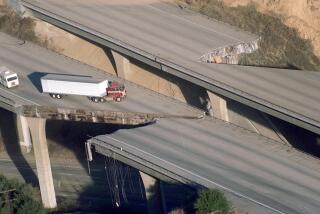Ship Looks for Sea-Floor Traces of Seattle Quake
- Share via
ABOARD THE NOAA SHIP RAINIER — They call it “mowing the lawn,” the sweeps made by high-tech launches dispatched from this federal vessel--each raking in thousands of reference points using sonar, computers and a global positioning system.
The 231-foot survey ship and its 60-member crew--all scientists as well as mariners--are conducting an emergency survey at the request of the U.S. Geological Survey to determine whether the recent magnitude-6.8 earthquake did any underwater damage that could threaten three major Puget Sound ports.
The focus is three river deltas--the Puyallup at the Port of Tacoma, the Nisqually north of Olympia and the Duwamish at the Port of Seattle.
Normally, the Rainier would be en route to Alaska about now, which could mean “40-knot winds and rain blowing sideways,” Cmdr. Dan Herlihy said last week as his ship sat anchored in flat-calm water and sunshine off the south end of Vashon Island, near Tacoma.
The launches, working to complete the Puyallup survey, were out in Commencement Bay, ducking among big ships and docks at a speed of 6 or 7 knots to cover every inch of the bay in overlapping swaths.
Concerns were raised by a local geologist who noticed underwater plumes of sediment after the quake.
The Tacoma and Seattle deltas house very large port facilities and “big harbor equipment,” noted James V. Gardner of the USGS office in Menlo Park, Calif. At Nisqually, the concern is the narrow shipping channels used to reach Olympia, a busy timber port.
And none of the deltas has ever been surveyed with modern equipment, said Gardner, chief of Pacific sea-floor mapping for USGS.
So it will be difficult to determine whether any damage spotted by the Rainier occurred three weeks ago or years back, he said. Any anomaly could be new, or “it could be ancient.”
Because the Feb. 28 quake did not trigger a tsunami, severe submarine damage is not expected, he said. The survey’s primary goal is to compile baseline data for comparison next time a major quake strikes the region--”and there will be a next time,” Gardner said.
USGS wanted to move quickly with the surveys because the sound’s strong tides “are going to erase shallow features very rapidly,” he said. “If we waited a month or two, they’d be obliterated.”
The Rainier and four of its survey vessels are equipped with multi-beam sonar, which provides a fan-shaped array of 101 to 120 beams that sweep the bottom to maximum depths of 300 yards. Each beam sends back eight to 10 soundings, or “pings,” per second, so the array provides 800 to 900 readings per second.
The technology has been employed for more than 20 years by the Navy. NOAA began using it in the mid-1990s to make nautical charts--typically involving shallow areas of more concern to mariners--but had only done spotty surveys in Puget Sound. Its focus has been Alaska, where many areas have never been surveyed by any means.
Data processed on the Rainier provided stunningly precise images of the Puyallup delta.
There was no sign of failure, nor of landslide--a collapse of the delta’s 6- to 7-degree slope onto the floor of Commencement Bay. Even if there had been, that is a natural process that doesn’t require earthquakes, Gardner said. Deltas are “notoriously active geological features.”
Much of Puget Sound was surveyed over the last 40 to 50 years with soundings every 30 meters. Whereas the older surveys provided only vague outlines of current and former Puyallup River channels and other features, the new data produced three-dimensional images based on soundings every 5 meters--each registering longitude, latitude and depth.
By the time the work is done, the image will reflect soundings every meter, Herlihy said.
Interpretation will take USGS a couple weeks at least, Gardner said.
More to Read
Sign up for Essential California
The most important California stories and recommendations in your inbox every morning.
You may occasionally receive promotional content from the Los Angeles Times.













